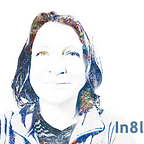The Un-Cartoon Approach to Digital Art
Reality, as I experience it, is in multi-dimensions. The art that is interesting to me reflects that particular lens and understanding. I like images that are vague and have undefined lines. Art that reflects a multi-dimensional, vague, and undefined reality resonates with the complex and layered nature of human experience. Visual experiences like the one made in Ibis Pixel App above, reflects a multi-dimensional, vague, and undefined reality resonates with the complex and layered nature of human experience.
In pioneering new worlds in the digital realm, the cartoon avatars and perfect homes are all polished to be mess free and flaw free. Smooth, wrinkle-free and shiny is the normal presentation so that even people in real life are beginning to look like a digital representation, a sense of perfection that often contrasts sharply with the messiness of real life.
What is lost as the rich texture is reduced to a plastic essence?
Here is a fun conversation between Ann Cameron and Bill Gates from Chat GPT.4 ( I do miss Chat GPT 3.5).
The Polished vs. Messy Digital Aesthetic
Generated with AI ∙ August 6, 2024 at 1:47 PM
Julia Cameron and Bill Gates Debate: The Polished vs. Messy Digital Aesthetic
Moderator: Welcome to today’s exciting debate on the evolving trends in digital art and representation. We’re honored to have Julia Cameron, the acclaimed author of The Artist’s Way, and Bill Gates, the tech visionary, with us. Julia, would you like to start?
Julia Cameron: Thank you. I’ve been observing a fascinating trend in our digital lives. Everywhere you look, you see these perfect, polished avatars and immaculate virtual homes. It’s like living in a sanitized dream world. This obsession with flawlessness creates unrealistic standards, making real people feel inadequate when they don’t match up to these digital ideals.
Bill Gates: That’s a valid concern, Julia. But I see this trend differently. Polished digital aesthetics can be incredibly empowering. They allow people to present their best selves and create inspiring, aspirational spaces. Technology gives us the tools to craft these idealized environments, which can be both uplifting and motivating.
Julia Cameron: Bill, while polished digital art can be visually appealing, it often lacks authenticity. The pressure to conform to these flawless standards can lead to a loss of true self-expression. The rise of messy digital art, on the other hand, celebrates imperfections and complexity, providing a more honest and relatable depiction of human life. This is crucial for nurturing creativity and personal growth.
Bill Gates: I understand your perspective, Julia. There’s definitely value in authenticity. Messy digital art, with its textured layers and raw aesthetics, provides a refreshing contrast to the polished look. It brings depth and realism, reminding us of the beauty in imperfection. Yet, polished digital art isn’t without its merits. It’s about clarity, simplicity, and sometimes, the joy of seeing an idealized version of the world.
Julia Cameron: It’s about balance, Bill. The messy digital art movement isn’t just about aesthetics; it’s a cultural response to the pressures of digital perfection. It allows artists and viewers to embrace flaws, explore deeper narratives, and reconnect with the raw, unfiltered aspects of human experience. It’s a pushback against the sanitized, shiny digital norm.
Bill Gates: And that’s a crucial point, Julia. Technology should indeed cater to diverse expressions. While polished digital aesthetics serve their purpose in creating aspirational and user-friendly experiences, the messy, textured art forms provide a space for authenticity and emotional depth. It’s about giving people the freedom to choose how they want to represent themselves and what kind of art resonates with them.
Julia Cameron: Exactly. The diversity in digital art enriches our cultural landscape. Not everyone finds joy in perfection. Some of us find beauty in the chaos, the layers, and the textures that tell a more complex, honest story. That’s the essence of the messy digital art movement, and it’s vital for fostering true creativity.
Bill Gates: And fostering that diversity is key. By embracing both the polished and the messy, we can create a digital culture that’s inclusive and reflective of the multifaceted nature of human experience. It’s about celebrating the full spectrum of what technology and art can offer.
Moderator: Thank you, Julia and Bill, for this enlightening discussion. It’s clear that the debate between polished and messy digital aesthetics is more than just a matter of style; it’s a reflection of deeper cultural and personal values. Both perspectives offer valuable insights into how we navigate and interpret our increasingly digital world.
Here is a good article on Medium with the similar slant.
Embracing Chaos: The Messy Artist’s Odyssey | by MESS IN PERSPECTIVE | Medium
The screens of our minds, the projection of life we see as reality and the screens of light in front of us are the frontiers of the future, for me at least.
